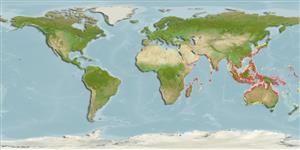Common names from other countries
Classification / Names / Names
ماع يماسا | فدارتم | Catalog of Fishes (gen., sp.) | ITIS | CoL | WoRMS
Environment: milieu / climate zone / depth range / distribution range
يسانش موب
; قمع تارييغت 2 - 25 m (Ref. 3099). Tropical
Indo-West Pacific.
Length at first maturity / Size / Weight / نس
Maturity: Lm ? range ? - ? cm Max length : 16 cm TL (female)
Minimum depth from Ref. 80410. Subtidal (Ref. 106854). Stomatopods are predators that require living prey (Ref. 833).
Life cycle and mating behavior
غولب | لثم دیلوت | یزیر مخت | اه مخت | Fecundity | )ورال ( دازوت
Some members of the order Stomatopoda pair for life and some come together only to mate. Males produce sperm ducts rather than spermatophores; females can brood a maximum of 50,000 eggs. Life cycle: Eggs hatch to a planktonic zoea which lasts for 3 months.
یلصا ذخآم
عجارم | هدننك گنهامه | ناراكمه
Ahyong, S.T. 2001. (Ref. 3099)
NCUI زمرق تسرهف رد تيعضو (Ref. 130435)
ستياس رظن زا تيعضو (Ref. 108899)
Not Evaluated
Not Evaluated
اه ناسنا یارب رطخ
Harmless
یناسنا هدافتسا
| FishSource |
اهرازبا
يتنرتنيا عبانم
Estimates based on models
Preferred temperature
(Ref.
115969): 23.1 - 29.3, mean 28.3 (based on 3216 cells).
